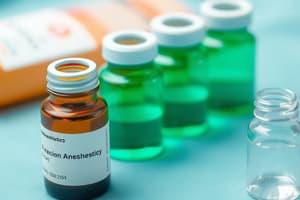Podcast
Questions and Answers
What are the major symptoms associated with local anesthetic systemic toxicity (LAST)?
What are the major symptoms associated with local anesthetic systemic toxicity (LAST)?
- Dizziness and hyperactivity
- Nausea and vomiting
- Abdominal pain and fever
- Seizures and cardiac arrest (correct)
What effect does the addition of vasoconstrictors have on local anesthetics? (select 2)
What effect does the addition of vasoconstrictors have on local anesthetics? (select 2)
- Increases risk of intravascular injection
- Decreases potency of the anesthetic
- Prolongs the duration of action and depth of blockade (correct)
- Decreases systemic absorption by (correct)
Which site of administration has the highest rate of systemic absorption for local anesthetics?
Which site of administration has the highest rate of systemic absorption for local anesthetics?
- Epidural site
- Spinal site
- Intercostal site (correct)
- Caudal
What factor increases the likelihood of systemic absorption of local anesthetics?
What factor increases the likelihood of systemic absorption of local anesthetics?
What is the effect of using a local anesthetic with a low pKa?
What is the effect of using a local anesthetic with a low pKa?
Which of the following patient factors is associated with increased plasma levels of local anesthetics?
Which of the following patient factors is associated with increased plasma levels of local anesthetics?
What is the primary mechanism by which local anesthetics prevent sensory impulse transmission to the brain?
What is the primary mechanism by which local anesthetics prevent sensory impulse transmission to the brain?
What is the purpose of aspirating before injecting local anesthetics?
What is the purpose of aspirating before injecting local anesthetics?
What is indicated by an increase in heart rate (+10) and systolic blood pressure (+15) after administering a test dose of a local anesthetic?
What is indicated by an increase in heart rate (+10) and systolic blood pressure (+15) after administering a test dose of a local anesthetic?
Which of the following is a common additive to local anesthetic solutions used to increase depth and duration?
Which of the following is a common additive to local anesthetic solutions used to increase depth and duration?
What should be avoided when injecting local anesthetics with vasoconstrictors? (select 2)
What should be avoided when injecting local anesthetics with vasoconstrictors? (select 2)
Which agent should be avoided in patients at risk for dysrhythmias or systemic hypertension?
Which agent should be avoided in patients at risk for dysrhythmias or systemic hypertension?
What is the first-line antiarrhythmic treatment for local anesthetic systemic toxicity (LAST)?
What is the first-line antiarrhythmic treatment for local anesthetic systemic toxicity (LAST)?
In managing anaphylaxis, which of the following is NOT a typical initial management step?
In managing anaphylaxis, which of the following is NOT a typical initial management step?
What is the maximum recommended dose of lipid emulsion in the treatment of LAST?
What is the maximum recommended dose of lipid emulsion in the treatment of LAST?
What type of allergic reaction is primarily associated with anaphylaxis?
What type of allergic reaction is primarily associated with anaphylaxis?
Which pathways activate the complement system?
Which pathways activate the complement system?
Which medication could potentially cause red man syndrome (an anaphylaxis mimic) when administered too rapidly?
Which medication could potentially cause red man syndrome (an anaphylaxis mimic) when administered too rapidly?
What is the purpose of administering a lipid emulsion in cases of LAST?
What is the purpose of administering a lipid emulsion in cases of LAST?
Which agents are considered a common cause of anaphylaxis associated with neuromuscular blocking agents?
Which agents are considered a common cause of anaphylaxis associated with neuromuscular blocking agents?
What immediate physiological response is mediated by histamine during anaphylaxis?
What immediate physiological response is mediated by histamine during anaphylaxis?
What is one of the clinical presentations typical of anaphylaxis during surgery?
What is one of the clinical presentations typical of anaphylaxis during surgery?
Which of the following is NOT commonly associated with increased risk for anaphylaxis in an anesthesia setting?
Which of the following is NOT commonly associated with increased risk for anaphylaxis in an anesthesia setting?
What are amide local anesthetics metabolized by?
What are amide local anesthetics metabolized by?
What are ester local anesthetics metabolized by?
What are ester local anesthetics metabolized by?
Amide LA have 2x"i" in name
Ester LA have 1x"i" in name
Amide LA have 2x"i" in name Ester LA have 1x"i" in name
Which of the following properties are associated with more toxic local anesthetics? (Select all that apply)
Which of the following properties are associated with more toxic local anesthetics? (Select all that apply)
What property of local anesthetics (LA) is associated with increased potency?
What property of local anesthetics (LA) is associated with increased potency?
What property of local anesthetics is associated with increased duration of action?
What property of local anesthetics is associated with increased duration of action?
What protein are local anesthetics mostly bound to?
What protein are local anesthetics mostly bound to?
“I Think I Can Push Each Bolus SSlowly For Safety"
IV, tracheal, intercostal, caudal, paravertebral, epidural, brachial, spinal, sciatic/femoral, SQ
“I Think I Can Push Each Bolus SSlowly For Safety" IV, tracheal, intercostal, caudal, paravertebral, epidural, brachial, spinal, sciatic/femoral, SQ
What is a characteristic of highly ionized local anesthetics?
What is a characteristic of highly ionized local anesthetics?
What is the pKa of a drug?
What is the pKa of a drug?
Lean body weight is used for dosing local anesthetics
Lean body weight is used for dosing local anesthetics
What effect does decreased plasma protein have on the systemic absorption of local anesthetics?
What effect does decreased plasma protein have on the systemic absorption of local anesthetics?
How does acidosis affect the systemic absorption of local anesthetics?
How does acidosis affect the systemic absorption of local anesthetics?
What metabolic conditions result in increased risk of systemic absorption of local anesthetics (LA)?
What metabolic conditions result in increased risk of systemic absorption of local anesthetics (LA)?
Supplemental oxygen is recommended for peripheral nerve blocks
Supplemental oxygen is recommended for peripheral nerve blocks
Which patients are at an increased risk of LAST (Local Anesthetic Systemic Toxicity) due to increased local anesthetic uptake?
Which patients are at an increased risk of LAST (Local Anesthetic Systemic Toxicity) due to increased local anesthetic uptake?
Which patient populations have decreased levels of alpha-1 acid glycoprotein? (Select all that apply)
Which patient populations have decreased levels of alpha-1 acid glycoprotein? (Select all that apply)
Which patients have increased sensitivity to the effects of local anesthetics? (select 2)
Which patients have increased sensitivity to the effects of local anesthetics? (select 2)
How should local anesthesia (LA) be administered in terms of dosage and timing between injections?
How should local anesthesia (LA) be administered in terms of dosage and timing between injections?
In LAST (Local Anesthetic Systemic Toxicity), which symptoms typically appear first?
In LAST (Local Anesthetic Systemic Toxicity), which symptoms typically appear first?
Which local anesthetic is associated with difficult resuscitation after LAST (Local Anesthetic Systemic Toxicity) cardiac collapse?
Which local anesthetic is associated with difficult resuscitation after LAST (Local Anesthetic Systemic Toxicity) cardiac collapse?
Which of these medications should be avoided in LAST? (Select all that apply)
Which of these medications should be avoided in LAST? (Select all that apply)
What type of lipids are used to treat Local Anesthetic Systemic Toxicity (LAST) ?
What type of lipids are used to treat Local Anesthetic Systemic Toxicity (LAST) ?
Lipid emulsion dose for <70 kg
1.5 ml/kg IV bolus then 0.25 ml/kg/min
Lipid emulsion dose for <70 kg 1.5 ml/kg IV bolus then 0.25 ml/kg/min
Lipid emulsion dose for >70 kg
100 ml IV bolus then 250 ml
Lipid emulsion dose for >70 kg 100 ml IV bolus then 250 ml
Why does LAST (local anesthetic systemic toxicity) typically present with excitatory symptoms first?
Why does LAST (local anesthetic systemic toxicity) typically present with excitatory symptoms first?
What are early signs of local anesthetic systemic toxicity (LAST)?
What are early signs of local anesthetic systemic toxicity (LAST)?
What do local anesthetics preferentially bind to? (select 2)
What do local anesthetics preferentially bind to? (select 2)
What is Exparel?
What is Exparel?
What is the effect of steroids on local anesthetics?
What is the effect of steroids on local anesthetics?
What effect do opioids and alpha-2 agonists have on local anesthetics?
What effect do opioids and alpha-2 agonists have on local anesthetics?
Which local anesthetic adjunct results in a quicker onset?
Which local anesthetic adjunct results in a quicker onset?
Which local anesthetics are associated with methemoglobinemia? (Select all that apply)
Which local anesthetics are associated with methemoglobinemia? (Select all that apply)
What substance is associated with causing bronchoconstriction in anaphylaxis?
What substance is associated with causing bronchoconstriction in anaphylaxis?
What causes the release of chemical mediators in anaphylaxis?
What causes the release of chemical mediators in anaphylaxis?
What is complement activation?
What is complement activation?
Agents can cause allergic reactions by more than one mechanism
Agents can cause allergic reactions by more than one mechanism
Which part of neuromuscular blocking agents is known to cause anaphylaxis?
Which part of neuromuscular blocking agents is known to cause anaphylaxis?
What is latex fruit syndrome?
What is latex fruit syndrome?
Egg allergy is not a contraindication to propofol use
Egg allergy is not a contraindication to propofol use
Alpha-gal syndrome can cause anaphylaxis to which animal-derived products?
Alpha-gal syndrome can cause anaphylaxis to which animal-derived products?
In which patient population are allergic reactions more common? (select all that apply)
In which patient population are allergic reactions more common? (select all that apply)
Perioperative anaphylaxis is more likely to present as CV collapse
Perioperative anaphylaxis is more likely to present as CV collapse
What clinical sign may be the only manifestation of an allergic reaction under general anesthesia?
What clinical sign may be the only manifestation of an allergic reaction under general anesthesia?
Which lab value can help differentiate anaphylaxis from other conditions?
Which lab value can help differentiate anaphylaxis from other conditions?
Most common cause of anaphylaxis in US is (1) antibiotics, (2) neuromuscular blocking agents, (3) chlorhexidine
Most common cause of anaphylaxis in US is (1) antibiotics, (2) neuromuscular blocking agents, (3) chlorhexidine
What part of penicillin and cephalosporins are people usually allergic to?
What part of penicillin and cephalosporins are people usually allergic to?
Which medications are indicated for the pretreatment of patients at risk of anaphylaxis? (Select all that apply)
Which medications are indicated for the pretreatment of patients at risk of anaphylaxis? (Select all that apply)
Why would increasing volatile anesthetics to treat bronchospasm during anaphylaxis be a poor choice?
Why would increasing volatile anesthetics to treat bronchospasm during anaphylaxis be a poor choice?
What is the treatment for refractory hypotension in anaphylaxis?
What is the treatment for refractory hypotension in anaphylaxis?
What time period do most anaphylaxis reactions occur after drug administration?
What time period do most anaphylaxis reactions occur after drug administration?
Which of the following drugs are known to cause nonimmunologic histamine release? (Select all that apply)
Which of the following drugs are known to cause nonimmunologic histamine release? (Select all that apply)
Flashcards are hidden until you start studying
Study Notes
Local Anesthetic Systemic Toxicity (LAST)
- LAST arises from the absorption of local anesthetics (LAs) leading to cardiovascular and neurologic toxicity.
- Minor symptoms of LAST include tinnitus, periorbital numbness, and a metallic taste.
- Major symptoms can escalate to seizures and cardiac arrest.
- Two main classes of LAs:
- Aminoester: Metabolized by plasma cholinesterase, characterized by an ester link.
- Aminoamide: Metabolized by hepatic CP450 enzymes, characterized by an amide link.
- All LAs act as voltage-gated sodium channel blockers, preventing depolarization and sensory impulse transmission to the brain.
- pKa indicates the ionization level of LAs; lower pKa means higher toxicity due to increased lipophilicity and lower protein binding.
- LAs mainly bind to alpha-1 glycoprotein; binding decreases in neonates and pregnant individuals.
- Injection procedures should include aspiration to avoid intravascular injection and administer in small doses (5 mL at a time).
Factors Affecting Systemic Absorption of LAs
- Total dose administered; larger doses heighten systemic absorption risk.
- Injection site vascularity is crucial; more vascular areas like the face allow for greater systemic absorption.
- Vascularity ranking for systemic absorption: IV > tracheal > intercostal > caudal > paravertebral > epidural > brachial > spinal > sciatic/femoral > SQ.
- The addition of vasoconstrictors, like epinephrine, can reduce systemic absorption by 20-50% and prolong LA action.
- Patient factors such as decreased plasma protein, metabolic disturbances, and extremes of age increase systemic absorption risk.
- LAST has been linked to oral viscous lidocaine and topical applications.
Prevention and Management of LAST
- Ensure emergency resuscitation equipment is readily available, including airway management tools and lipid emulsion therapy.
- Continuous patient monitoring is essential during regional anesthesia.
- Aspirate before injection, use ideal body weight for dosing, and accommodate patient-specific risk factors.
- Monitor heart rate (increase of +10) and systolic blood pressure (increase of +15) response to epinephrine or vasoconstrictors post-injection.
- Maximum allowable doses for various LAs must be known and adhered to.
- Bupivacaine poses the highest risk for cardiac collapse with challenging resuscitation following toxicity.
Treatment of LAST
- Immediate assistance is critical; secure the airway and administer 100% oxygen.
- Treat seizures with small doses of propofol; muscle relaxants may not prevent seizures.
- Manage arrhythmias with first-line antiarrhythmic amiodarone, avoiding Na+ channel blockers and certain vasodilators.
- Lipid emulsion therapy involves administering 1.5 mL/kg and up to 12 mL/kg maximum dosage; mechanisms may include lipid sink and shuttle theories.
Anaphylaxis in Anesthesia
- Anaphylactic reactions typically arise in the OR, often from IV drugs within 5 minutes post-administration.
- The reaction begins localized before spreading systemically; about 60% of reactions are type 1 IgE mediated.
- Key chemical mediators include histamine (vasodilation) and prostaglandin D2 (bronchoconstriction), leading to severe physiological responses.
Common Causes and Risk Factors for Anaphylaxis
- Most common triggers include antibiotics, neuromuscular blocking agents, and chlorhexidine.
- Penicillin, especially with its beta-lactam group, is notoriously associated with allergic reactions.
- Neuromuscular blockers like succinylcholine have a history of producing anaphylactic reactions upon second exposure.
- Risk factors include prior allergic reactions, female sex, mast cell disorders, asthma, and chronic exposure to latex products.
Management Strategies for Anaphylaxis
- Immediate cessation of the offending agent and airway management, supplemented with high-flow oxygen.
- Initiate intravascular volume expansion and administer epinephrine promptly.
- Secondary treatments encompass antihistamines, corticosteroids, and vasopressin for refractory shock.
- Continuous monitoring of tryptase levels can help confirm the diagnosis of anaphylaxis within 30 minutes to 1 hour post-reaction.
Additional Considerations
- Monitor for bronchospasm; avoid volatile anesthetics as they may worsen myocardial depression.
- Ensure no needle passes through multi-dose vials with natural rubber stoppers to minimize latex allergy risk.
- Treat allergic reactions meticulously to prevent severe outcomes, focusing on early recognition and intervention.
Studying That Suits You
Use AI to generate personalized quizzes and flashcards to suit your learning preferences.




